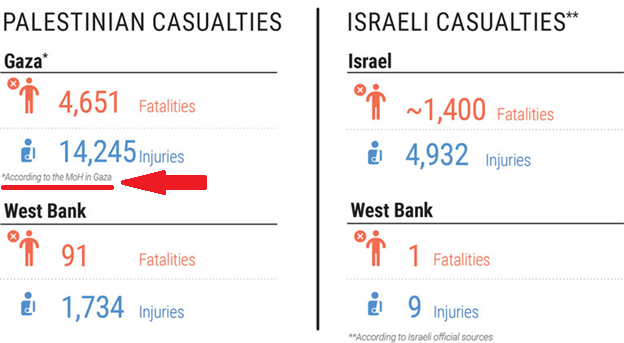The world saw a real time example last week of how journalists are not being forthright with their audiences about the Israel-Hamas war. When an explosion went off at Al-Ahli hospital parking lot, media outlets immediately began spreading “Palestinian health ministry” reports that hundreds were killed by an Israeli strike on the hospital itself. As we now know, this account was wildly inaccurate in more than one way. The parking lot, not the hospital itself, was hit by an Islamic Jihad rocket.
But the incident shed light on another way in which journalists are failing their audiences: specifically, how they are reporting on casualty figures.
After the Ahli hospital explosion, as with the false assertion that it was an Israeli bomb, the media breathlessly repeated “Palestinian health ministry” claims that hundreds had been killed. Few, if any, major media outlets informed their audiences that the “Palestinian health ministry” was an entity of the internationally designated terrorist organization Hamas, thus leaving viewers without necessary knowledge to judge the reliability of the claims. In at least one case, CNN even deceptively wrote of the “Palestinian health ministry” and “Hamas” as if they were entirely separate entities.
Although several media outlets have published mea culpas on how they covered the hospital story, they are still actively spreading some of the same misinformation. Every time they cite the “Palestinian health ministry” for the number of casualties in Gaza, they are relying on Hamas figures. Those Hamas figures include the over 470 deaths Hamas still claims occurred at Al-Ahli hospital. Though precise figures are not available, European intelligence sources suggest that the real number of fatalities is likely in the 10-50 range. In other words, Hamas is inflating total fatality figures by as many as 400+ deaths from just one incident alone.
The need to treat Hamas figures with serious skepticism is also born out by past conflicts. For example, after Operation Cast Lead in 2008-9, Hamas and Palestinian NGOs, as well as B’Tselem (which itself relies largely on Hamas’ figures), claimed that of the 1,100-1,400 Palestinians killed, only 250-330 were terrorists. The media and the United Nations ran with these figures. It wasn’t until a year later that Hamas admitted that approximately 700 of its members were killed, a figure similar to that which had been given by Israel and independent Israeli researchers after the conflict.
Importantly, the media cannot skirt its duty by relying on the United Nations. As it did in the above example, in which UN reports relied on inaccurate figures largely traceable to Hamas, the UN’s Office for the Coordination of Humanitarian Affairs (OCHA) is once again using Hamas figures.

A United Nations Office for the Coordination of Humanitarian Affairs graphic.
Notably, even where the UN isn’t relying on Hamas, UN figures have proven to be dramatically inaccurate. For example, a UN commission claimed that two-thirds of Palestinians killed in Operation Protective Edge were civilians, despite an in-depth examination of names by independent Israeli researchers providing evidence that half of the named fatalities were members of terrorist organizations. Even in regard to specific incidents, UN figures prove to be dubious. To take just one example, the infamous Goldstone Report depicted all 15 Palestinians killed at al-Maqadmah Mosque during Operation Cast Lead as “civilians.” However, open-source evidence, including from some of the UN’s own sources, shows that more than half of them were terrorist operatives.[1]
As CAMERA’s Tamar Sternthal has noted, too, even OCHA’s figures for casualties in Judea & Samaria are questionable. For example, OCHA is known to count Palestinians killed while carrying out terror attacks as fatalities from “incidents involving Israeli settlers,” thus deceptively inflating the issue of “settler violence.”
In short, UN data must also be treated skeptically, and audiences must be informed of its shortcomings, too.
Last week’s enormous failure in the media’s coverage of Al-Ahli hospital explosion had dramatic consequences. Diplomatic meetings were canceled. Rioters firebombed and destroyed synagogues. Even worse, the message delivered to those Palestinian terrorists responsible was that even when they kill their own civilians, Israel will be blamed. With IDF officials stating that the war will likely last multiple months, there will inevitably be more tragic incidents of civilian casualties. The media must not become an unintentional accomplice to Hamas’s strategy of placing its own civilians in harm’s way to win its morally obscene public relations battle.
Spreading Hamas propaganda without qualification or context is no different than uncritically airing Islamic State propaganda. Journalists must clearly articulate to their audiences that when they use Hamas casualty figures, they are relying on an internationally designated terrorist organization. The public should know those important factors that weigh on the credibility of such significant claims.
[1] B’Tselem itself admits that Ibrahim Musa ‘Issa a-Silawi, Hamed Hassan Abu ‘Aytah, Ahmad Sa’id Salah Sa’id Battah, ‘Omar ‘Abd al-Hafez Musa a-Silawi, and Yusef Ziad Ahmad Zaqut were all Hamas members, while Muhannad ‘Abd al-Hafez Musa a-Tanani was an Islamic Jihad terrorist. Open source research by Lt. Col. (ret.) Jonathan D. Halevi also identified that Rajah Nahad Rajah Ziyyada and Ahmed Assad Diyab Tabil were also terrorists from Islamic Jihad and Hamas respectively. Both also appear in B’Tselem’s database as having been killed at the mosque, but B’Tselem omits their terrorist affiliations.
